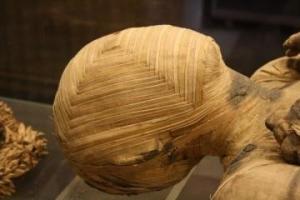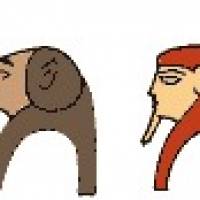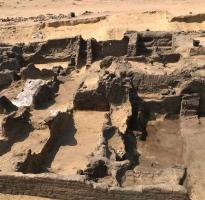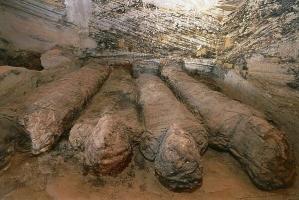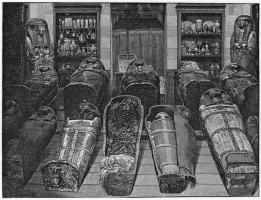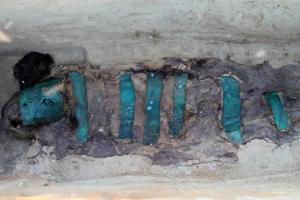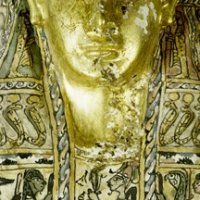Notes on mummies
In the ancient Egypt the cult of the dead was connected to the religion: convinced of the immortality of the soul, the Ancient Egyptians believed that it would, from time to time, return to visit its body, but that it could not live peacefully in the afterlife unless the body was kept intact (if the body decomposed, the soul would also be decomposed).
This is why the complex technique of embalming takes on fundamental importance in Egyptian culture. Body preservation by mummification is perhaps the Egyptian religious practice best known even to laymen and one of the most impressive features of the Nile civilization.
Moreover, it should not be forgotten that Egypt's arid climate contributes to the preservation of corpses by desiccating them, while elsewhere, humidity destroys organic substances (in particular, animal tissues).
The name "mummy" has Greek origins. The Greeks called black-mummy the dye derived from bitumen or asphalt. During the colonization of Egypt, some corpses were found embalmed with asphalt or bitumen, and they said they had been sprinkled with black-mummy and, hence, the name mummy. Actually in Ancient Egypt there were two ways of calling the body of a dead person: the corpse was called "khat," while the embalmed body was called "wi".
The first rudimentary embalming techniques probably date back to the First Dynasty when only pharaohs were almost certainly embalmed.
Herodotus, during his trip to Egypt, described the embalming ritual with some precision:
upon the death of a man of some importance, the women of the house would smear their heads with mud and then leave the house, going around the village beating themselves. Men also performed the beating ritual. At the end of this custom the embalming of the body could begin. Professional embalmers were used to perform it. They would propose a number of models with associated costs. A brief negotiation was held in which the price and the type of embalming to be performed were defined. In Ancient Egypt there were three main methods by which to embalm a body:
- The first method, the most expensive, was presented according to the method that the god Anubis had adopted for the corpse of Osiris. The denuded body was laid on the ground with the head facing south. An embalmer, having recited a prayer, would introduce through the right nostril a curved iron and with it extract the brain. Having recited another formula, a scribe would draw a long line on the corpse's side over which another worker would make an incision with a sharp stone. Immediately afterwards one of the embalmers, introducing his hand through the opening, would quickly extract all the intestines. The organs extracted from the corpse were enclosed in vessels called canopic jars whose appearance recalled deities depicting the four sons of Horo: Imseti (human head), Duamutef (jackal head), Qebshnuf (hawk head), Hapi (monkey head). The name "canopic" was given by the scholars who first found them. The discovery was made in Canu, a small town near Alexandria, hence the name canopic. The abdominal cavity was first washed with palm wine and later with powdered aromatics and then filled with crushed myrrh, cassia and other aromatics, except frankincense, and finally stitched up. At this point the corpse was immersed in nitro where it was left for 70 days. At the end of this period the corpse was washed again, smeared with resins and cedar oil, and finally wrapped completely in thin, very long linen bandages impregnated with rubber. Amulets including scarabs were placed at each turn of the bandage; special formulas were recited for each amulet placed. At the end of the bandage the mummy was returned to relatives.
- In case the intermediate procedure was chosen, to avoid too great an expense, the embalmers acted as follows: by means of syringes they filled the belly of the dead man with cedar oil without incising him and without extracting his viscera, but injecting the liquid from the anus. Then they place the corpse in nitro for a period of 70 days. On the last day they extract the cedar oil from the abdominal cavity, which comes out with such violence that it drags with it the intestines and other viscera that are now macerated: only the skin and bones remain of the body.
- The third system, consists of cleaning the intestines with an enteroclysm, and impregnating the body with nitro for the stipulated 70 days.
As is easy to relaize, a real funeral business sprang up in Egypt made up of professionals who carried out the various embalming required.
Herodotus specifies that, in the case of the death of very beautiful women, the body was handed over to the embalmers only 3 to 4 days after death to prevent the embalmer from taking advantage of the deceased's body. On the other hand, in the case of death that occurred in the Nile, the village where the corpse was found had to take care of the burial in the most respectful manner. The body could be touched only by the priests of the Nile who buried it as a superhuman being.
From the 3rd Dynasty the first viscera extractions begin, while the process of washing the body should date back to the 5th Dynasty.
The ritual of embalming, in addition to Herodotus, is also described in the Boulaq papyrus and in the Papyrus No. 5158. They date from the 1st century AD, but are certainly a copy of a document dating from the New Kingdom. These papyri detail the last stage of embalming, namely the material actions and prayers to be recited:
- Anointing of the head with anti
- Anointing of the body with 10 different kinds of oils
- Placement of the viscera in a jar where they will be impregnated with "the divine essence"
- Preparation of the back
- Positioning of the body so as not to spill the various oils
- Gilding of fingernails and toenails; fingers are bandaged separately and then covered with finger capsules
- Final anointing and bandaging of the head. Before the bandaging, precious stones (turquoise and lapis lazuli) are placed in the openings of the head. There is a specific number of rounds of special bandages, after which the whole is covered with a 4 cm wide bandage. The garment thus wrapped is sprinkled with a special oil that must penetrate between the bandages to ensure adherence with the face
- Finishing the head. Some plant products are placed under the head while sprinkling the head with oils and perfumes
- Bandaging of the arms. The bandages are painted with images of gods
- Warnings for right and left hand bandaging and final bandage
- Anointing, perfuming, bandaging and wrapping of legs with designs of gods. The papyrus ends with these words, "You revive, you revive forever; you are young again, you are young again forever."
The times for embalming are known: embalming begins 4 days after death, banding begins 52 days after the beginning of embalming, deposition in the sarcophagus 16 days after the beginning of banding, and burial 3 days after deposition in the sarcophagus.
The various stages of the embalming process were established by Leca in 1976 after careful study:
- Ablation of the brain
- Evisceration
- First washing of the body
- Processing of the viscera
- Dehydration of the body
- Second washing
- Filling of the skull and abdominal and thoracic cavities
- Treatment of the nails, eyes, and genitals
- Anointing and massage of the body
- Application of a metal plate on the flank incision
- Treatment of the body with resin
- Bandage
Of particular importance was the dehydration phase. Herodotus says that the body of the deceased was "dipped in nitro" without specifying how. Some experiments supported by Lucas prove, leaving no doubt, that the best results were obtained by sprinkling the body with dry natron.










